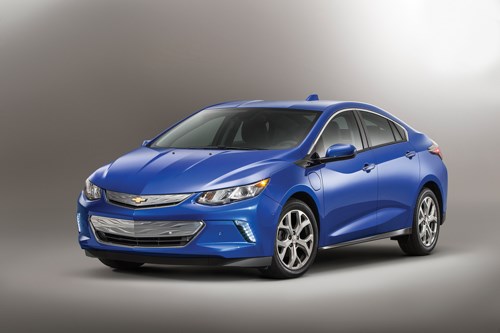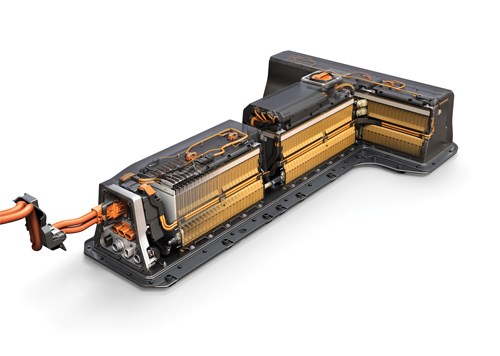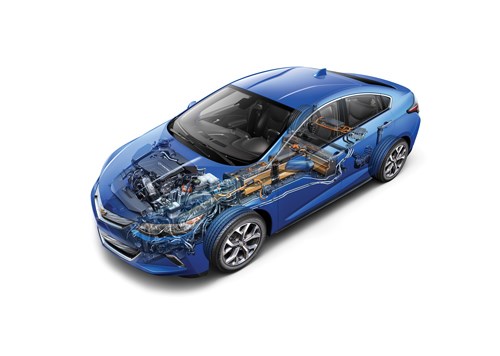
The 2016 Chevy Volt, says designer John Cafaro, was designed to look “dynamic,†not like a jellybean.

John Cafaro has designed cars like the Corvette and trucks like the Silverado. This time, the assignment was the extended range electric vehicle, the 2016 Volt.

GM’s Pam Fletcher says that the new battery system has 192 cells compared with the 288 of the previous Volt. She points out that this means fewer parts, which means there is a reduced potential for things to go wrong. They continue
to use an active thermal system. The
energy storage has gone from
17.1 kWh to 18.4 kWh.

The 2016 Volt is all-new, inside and out, from the sheet metal to the drive system.
Previous
Next
Related:
Automotive Design
Automotive Engineering
John Cafaro has been designing cars and trucks at General Motors for a long time.  In June 2015, it will be 38 years.  He’s worked on all manner of vehicles in his time with the company.  Among his favorites, of course, are Corvettes and Camaros.  And he also brings up the pickups.  He’d gone from the C5 Corvette to the GMT-900 truck. (Vehicles he worked on he didn’t like?  “We’ll have to talk about those another time.† Maybe after he’s retired.)
Cafaro is presently executive director of Design for Global Chevrolet Cars.  And he led a team that had just gotten off of the Impala program—a program that transformed a ho-hum sedan into something that has style and presence in a way that sedans in Chevy showrooms haven’t had for quite some time—on the second-generation Volt program.
If you want to have a single takeaway, it’s this: “I got the chance to make it look cool and exciting.â€
Mind you, Cafaro said that he and his team like the Gen 1 Volt design.  But with the all-new platform (Pam Fletcher, executive chief engineer, Electrified Vehicles, says, “This is an all-new car—the architecture, interior, exterior, propulsion system.  It was a clean sheet.â€), they had the opportunity to make some changes to what is a well-loved, albeit among a fairly limited number of people (there have been a total of some 73,000 Volts sold since it went on sale as a model year 2011 car at the end of 2010, and by way of comparison, for calendar year 2014, 140,280 Impalas were sold) car.
“We wanted to make this Volt very dynamic.  It doesn’t look like a jelly bean or quirky,†Cafaro says.  He goes on to say, “We decided to make it sporty rather than have people look at it and say ‘It’s a hybrid.’† That is, he explains that regardless of what it has under its hood (and in case you’re wondering, what it has under its hood is its “range-extender,†a.k.a., a 1.5-liter, four-cylinder engine; it also has two motors that provide 111 kW to drive the front wheels, and Fletcher points out that most of the time—as in greater than 80%—current Volt owners are taking trips on electricity alone, without the range extender kicking in, and the 2016 model has a new battery, so the electric-only range is 50 miles, compared with 38 for the 2015), they want the car to be striking.
He says the front end continues with the first generation’s design, but they’ve added what he describes as “a very technical grille texture.† Realize that the upper grille is shut; the lower grille (with the two-grille approach being a look that is used on other Chevy sedans) is the one that lets the air in and it, Andrew Farah, Volt chief engineer, says, has active shutters to aid mileage performance.  The lighting is LED, including the DRLs that are pushed to the corners to help provide a wide, planted look.
The body sides are sculpted considerably more than on the Gen 1 car. Â Pointing to the lower portion of the doors, where there is a concavity, Cafaro says that the shape was one that was achieved in the wind tunnel, as they had a full-size clay model of the Volt in the tunnel and then watched how the air flowed over the surfaces. Â Seeing that there was a possibility of achieving some improvement, they brought the car back to the studio and carved out clay, then reran the test to see how the shape performed aerodynamically.
“Aero is a black art,†Cafaro, who says he’s spent plenty of time in a wind tunnel, notes, adding, “Sometimes things just happen and they become best practices.â€
Around back, the car is tapered, and the tail lamps and the decklid form a spoiler. Â The roofline is lowered slightly, and there is a NACA duct form on the roof.
And one more thing: “If it looks a little like an Impala, that’s intentional,†Cafaro says.
“It used to be said that in every Chevrolet there is a little Corvette,†Cafaro says.  “Now it can be saidâ€â€”and Cafaro’s talking about aero primarily—“that there is a little Volt in every Chevy.â€








